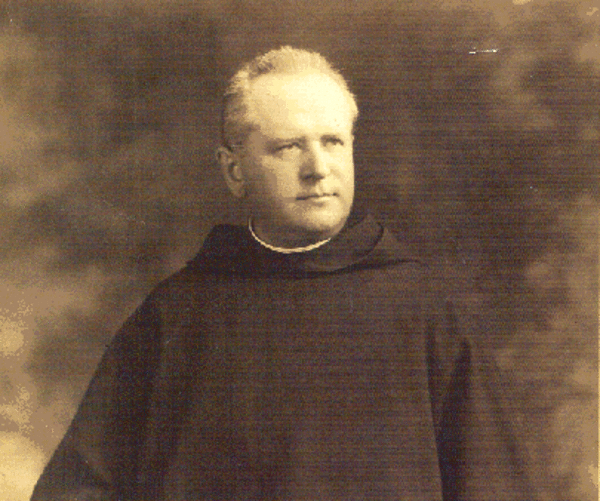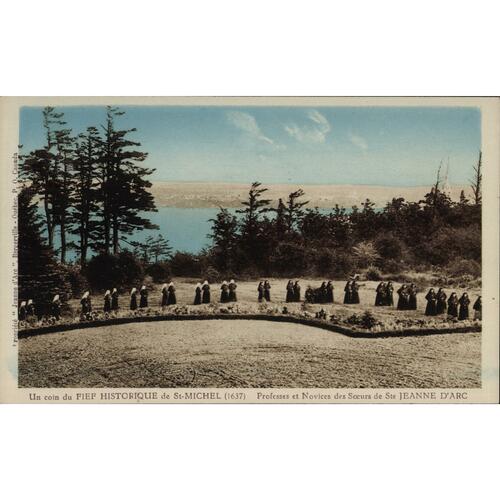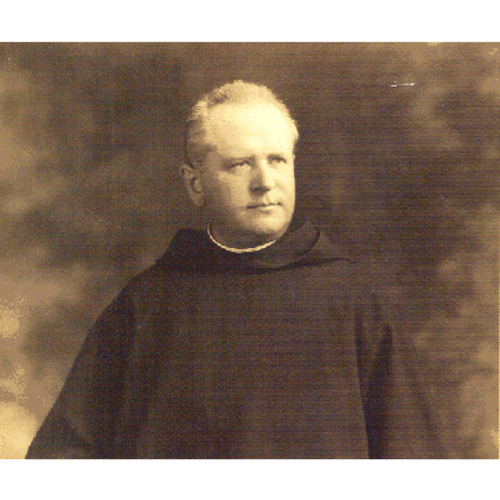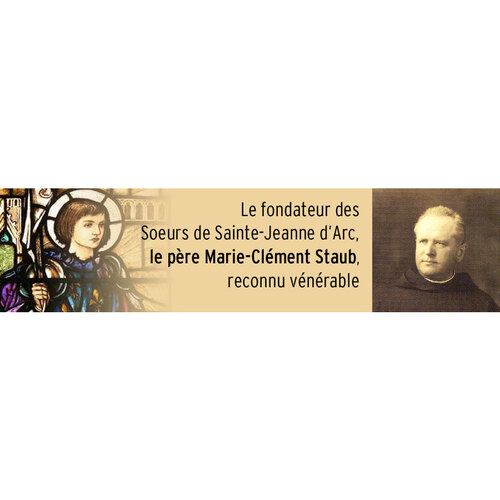
Source: Link
Staub, MARIE-CLÉMENT (baptized Joseph), Roman Catholic priest, member of the Assumptionists, preacher, and founder of the Sisters of Joan of Arc; b. 2 July 1876 in Kaysersberg (France), son of Clément Staub, a cooper, and Marguerite Hertig, widow of François-Joseph Weyhaupt; d. 16 May 1936 in Bergerville (Quebec City).
The youngest of four children of a Catholic family of modest means, Joseph Staub spent his childhood in Alsace-Lorraine, which was at the time annexed to the German empire. In November 1890 he entered the juniorate of the Assumptionists in Mauville (Fresnes-lès-Montauban), France. Since he was not academically gifted and was also required to learn French, he had to spend an extra year in study. On 6 Sept. 1896, at the noviciate of Livry (Livry-Gargan), Staub took the habit of the order and his new name, Marie-Clément. He stayed at Livry until 1898, and on 6 September that year made his perpetual vows. At the end of his studies, which he pursued at the scholasticates in Louvain, Belgium, and in Rome, he was awarded two doctorates, one in philosophy in 1903 and the other in theology in 1904. On 19 March 1904 he was ordained priest at the basilica of St John Lateran.
From 14 Aug. 1904 until the end of 1906 Father Marie-Clément was assistant master of novices at Louvain, and then, until 1908, he was master of novices in the new establishment reserved for lay brothers in Gempe (Tielt-Winge). A born leader and able preacher, he was chosen at the end of 1908 to found the first Assumptionist juniorate in England. The preferred theme of Father Marie-Clément’s sermons was the Sacred Heart. His correspondence with Édith Royer, a mystic who worshipped the Sacred Heart, had indeed convinced him of the need to propagate the teachings of the Archiconfrérie de Prière et de Pénitence, a confraternity founded on 18 April 1894 whose members undertook, in honour of the Sacred Heart, to pray and do penance for the conversion of sinners.
On 21 Nov. 1909 Father Marie-Clément was told by Father Emmanuel-Joseph Bailly, the superior general of the Assumptionists, that he was to leave for America to preach and spread the ideas of the confraternity. Although he wrote in his journal that he felt “a natural revulsion for those distant countries,” he settled the following month into Assumption College in Worcester, Mass., in the diocese of Springfield. His ministry there at St Anne’s Orphanage, which was administered by the Sisters of Charity of the Hôpital Général of Montreal (Grey Nuns), gave him the opportunity to publicize the work of the Assumptionists and the confraternity even in the province of Quebec. Father Marie-Clément took part in the International Eucharistic Congress of Montreal in 1910, and in February and July 1912 he preached three retreats to the Grey Nuns in the same city.
A year later Father Marie-Clément met Alice Caron; the encounter was to have a decisive influence on his life. Born in Quebec and housekeeper of the presbytery of a parish in Springfield, she suggested that he start a religious community devoted to the service of priests and dedicated to Joan of Arc and the Sacred Heart. Father Marie-Clément formed the Sisters of Joan of Arc privately in 1914 during a midnight mass, in the presence of Alice Caron and two future spiritual sisters. Despite the reservations of his bishop, Thomas Daniel Beaven, Father Marie-Clément founded it publicly on 31 December during the holy hour (spent meditating on the Eucharist) while four other spiritual sisters were present. He noted in his journal that he asked the sisters to be “victims giving their outer life for the priests: exertion, labour, fatigue, and dedication” as well as “giving [to the priests] their inner life: atonement, prayers, immolations, mortifications, crucifixions.” The designation of the nuns as “victims” would not appear in the constitutional documents of the community, which were approved in 1921.
In 1917 Father Marie-Clément asked Cardinal Louis-Nazaire Bégin* and Bishop Paul-Eugène Roy* for permission to establish, in the archdiocese of Quebec, the Sisters of Joan of Arc, the Assumptionists, and the Archiconfrérie de Prière et de Pénitence; the confraternity had become “one of the undertakings of [the] ministry [of the Assumptionists] in the United States and Canada” since the publication in 1914 of a circular from Father Emmanuel-Joseph Bailly. The cardinal accepted these groups on 2 March 1917, but with the stipulation that they be located outside Quebec City.
On 2 July a piece of land in the countryside on the banks of the St Lawrence River, at Bergerville, was purchased from the archdiocese on behalf of the Sisters of Joan of Arc for $36,000. The first seven nuns, who came from Worcester, arrived in Quebec City on 21 September and took the habit of the community eight days later. They lived in the parish of Saint-Jean-Baptiste where the Archiconfrérie de Prière et de Pénitence was located. Its Canadian centre was inaugurated on 25 December by the cardinal and was incorporated into the Archiconfrérie of Montmartre in Paris. On 28 Aug. 1918 the Sisters of Joan of Arc moved into their mother house; built in Bergerville in the French style of old fortified castles at a cost of $48,000, it also housed the secretariat of the confraternity. The nuns elected the first council of the Sisters of Joan of Arc on 13 Aug. 1920. Cardinal Bégin established the community canonically on 15 August and he approved the constitutional documents on 16 May 1921.
On behalf of the Assumptionists, Father Marie-Clément, who had settled in Quebec City, bought land from the Redemptorists adjacent to that of the Sisters of Joan of Arc for $50,000 on 13 Aug. 1921. He took part in drawing up the plans and oversaw the building of the Assumptionists’ noviciate as well as the Canadian Montmartre (the chapel of the confraternity) on the new site; costs were estimated at $100,000. He dreamed of adding a basilica to these two buildings, which were inaugurated on 3 Sept. 1926 and 6 Jan. 1927 respectively. These projects were, however, to be his last for the Assumptionists and the confraternity. In 1924 Father Tranquille Pessoz was appointed superior of the Assumptionist community of Bergerville and in May 1925 Father Gervais Quénard, the superior general of the Assumptionists, asked Father Marie-Clément to withdraw from the confraternity. Even though the latter regularly demonstrated goodwill and his intention of submitting to authority, as he did in 1919 in a letter to Father Joseph Maubon, the vicar general of the Assumptionists, his superiors criticized him for, among other things, his lack of humility, his inability to acknowledge his mistakes, and the lack of transparency in the management of the various projects. After his departure, the number of people who registered to join the confraternity would drop from 6,046 in 1926 to 1,667 in 1936.
Father Marie-Clément retained his entrepreneurial spirit and, over the years, supervised the completion of other works for the Sisters of Joan of Arc on the Bergerville site: an extra wing for the mother house (1928), a monument to Joan of Arc (1931), a Lourdes grotto (1933), and a Calvary (1934). The monuments were largely financed by benefactors and by revenues from campaigns in the United States and Canada, leading some of his superiors such as Father Armanet Crescent, the provincial vicar of North America, to fear that Father Marie-Clément was using his Assumptionist membership to obtain money and was thereby harming their own funding drives. Furthermore, they were severely critical of the canvassing being done in the midst of a depression; the economic crisis would, in fact, delay the completion of the convent chapel of St Joan of Arc, and it was not finished until 1955–56. Father Marie-Clément also founded three organizations with connections to the Sisters of Joan of Arc: the Associés (1921), laypeople who lived in the spirit of the community; the Orantes (1924), nuns who because of age or physical condition assumed a contemplative role; and the Auxiliatrices (1931), nuns who renewed their vows for one year at a time. He also established communion for priests in 1924.
At the beginning of 1936 Father Marie-Clément felt a general weariness and had to curtail his activities. He died of a heart attack on 16 May. The Sisters of Saint Joan of Arc (so named since 6 Jan. 1931) then had 239 nuns working in 32 foundations scattered across Quebec, the United States, and France. His body lies in the basement of the mother house, which was to become a place of religious devotion. On 6 Jan. 1966 Cardinal Maurice Roy*, the archbishop of Quebec, would announce that the cause for beatification of Father Marie-Clément was now open.
Father Marie-Clément was endowed with a remarkable ability to adapt, great determination, a strong and enthusiastic nature enhanced by charisma, and a certain extravagance. For the most part, he had a better relationship with the archbishops of Quebec than with his Assumptionist superiors. The latter strongly disapproved of his excessive activity and his inability to accept criticism and to demonstrate humility. They refused to let him make his own decisions, demanding instead that he submit to the authority of his superiors. Nonetheless, acknowledging his piety and devotion, they allowed him to establish his projects and twice demanded that he move to other countries and set up new foundations, endeavours in which he was successful.
The official documents of Father Marie-Clément as well as excerpts from his diary and correspondence, among other items, are reproduced in Yves Garon et Yvon Beaudoin, Béatification et canonisation du serviteur de Dieu Joseph Staub, en religion père Marie-Clément Staub des Augustins de l’Assomption (1876–1936), fondateur de la congrégation des Sœurs de Sainte-Jeanne d’Arc: positio sur les vertus et la renommée de sainteté (2v., Rome, 2001–2).
Le Devoir, 18 mai 1936. W. J. Dufault, Marie Clément Staub, a.a., 1876–1936, apostle and founder (Sillery [Québec], 1990). Yvon Le Floc’h, Origine de la congrégation des Sœurs de Sainte-Jeanne d’Arc (Québec, 1964); P. Marie-Clément Staub, a.a., apôtre et fondateur, 1876–1936 (2v., [Québec?], 1967–68). Claire Quintal, Herald of love: Father Marie Clement Staub, a.a., apostle of the Sacred Heart and founder of the Sisters of Saint Joan of Arc, 1876–1936 (Sillery, 1984). Xavier Vandermeerschen, Marie-Clément Staub, a.a., 1876–1936, apôtre et fondateur (Sillery, 1991).
Cite This Article
In collaboration with Gilberte Paquet, “STAUB, MARIE-CLÉMENT (baptized Joseph),” in Dictionary of Canadian Biography, vol. 16, University of Toronto/Université Laval, 2003–, accessed December 14, 2025, https://www.biographi.ca/en/bio/staub_marie_clement_16E.html.
The citation above shows the format for footnotes and endnotes according to the Chicago manual of style (16th edition). Information to be used in other citation formats:
| Permalink: | https://www.biographi.ca/en/bio/staub_marie_clement_16E.html |
| Author of Article: | In collaboration with Gilberte Paquet |
| Title of Article: | STAUB, MARIE-CLÉMENT (baptized Joseph) |
| Publication Name: | Dictionary of Canadian Biography, vol. 16 |
| Publisher: | University of Toronto/Université Laval |
| Year of publication: | 2014 |
| Year of revision: | 2014 |
| Access Date: | December 14, 2025 |






